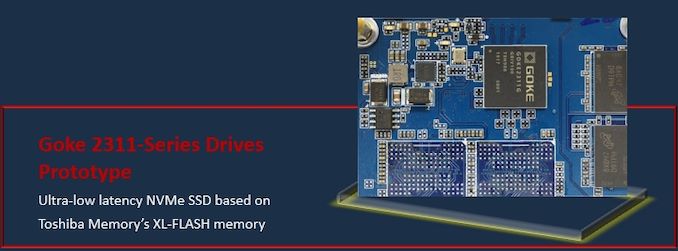Goke Unveils Toshiba XL-Flash-Based NVMe SSDs: Ultra-Low Latency
by Anton Shilov on October 2, 2019 10:00 AM EST
Goke Microelectronics has introduced its new NVMe SSDs based on Toshiba’s XL-Flash NAND memory. The new drives are aimed at applications that require an ultra-low latency as well as high reliability and availability.
Based on Goke’s proprietary 2311 controller and Toshiba’s XL-Flash NAND SLC flash memory, the company’s 2311-series SSDs feature capacities of up to 4 TB and promise to offer a 4K random read latency of less than 15 μs (an under 20μs was hit by prototype drives and the manufacturer plans to improve that) as well as a maximum sustained read/write bandwidth of up to 3/1 GB/s. When it comes to security, the controller supports SM2/3/4 and SHA-256/AES-256.
Goke’s 2311-series SSDs are the industry’s second family of drives (announced so far) featuring Toshiba’s XL-Flash 128 Gb XL (16 planes, 4 KB page sizes). This type of memory promises to significantly reduce read latency when compared to TLC 3D NAND based SSDs: from 20μs all the way to 15 μs in case of Gecko’s upcoming drives (or to 5 μs in an ideal case, based on Toshiba’s estimates).
Goke plans to start production of its 2311-series SSDs powered by Toshiba’s XL-Flash NAND memory sometimes in 2020. As the drives are aimed at select applications only, the maker does not disclose their pricing as it will depend on configuration and volumes.
Related Reading:
- Memblaze’s PBlaze5 X26: Toshiba’s XL-Flash-Based Ultra-Low Latency SSD
- Toshiba Announces XL-Flash Low-Latency 3D NAND
- Western Digital Develops Low-Latency Flash to Compete with Intel Optane
- Memblaze Launches PBlaze5 SSDs: Enterprise 3D TLC, Up to 6 GB/s, 1M IOPS, 11 TB
- The Memblaze PBlaze5 C916 Enterprise SSD Review: High Performance and High Capacities
- The Enterpise TLC Storage Era Begins: Rounding Up 13 SSDs With Samsung, Intel, and Memblaze
Source: Goke Microelectronics










8 Comments
View All Comments
vFunct - Wednesday, October 2, 2019 - link
This will be good for databases, as databases are a bunch of random lookups.ksec - Wednesday, October 2, 2019 - link
I guess this is good for the big enterprise or web company like Google and Facebook where they have their DB all optimised. For normal web dev, I dont think it will make a huge difference.phoenix_rizzen - Wednesday, October 2, 2019 - link
"maximum sustained read/write bandwidth of up to 3/1 GB/s."So, could that be simplified to just 3 GB/s? ;)
Or is that supposed to be 31 GB/s?
Elfear - Wednesday, October 2, 2019 - link
It's read/write speed.SirStephenH - Thursday, October 3, 2019 - link
No and no."as well as a maximum sustained read/write bandwidth of up to 3/1 GB/s."
That's 3GBps read and 1GBps write.
emvonline - Thursday, October 3, 2019 - link
This is good to compete with Samsung and Intel in the ultra high performance SSD market for enterprise/datacenter. I am not sure who would select Goke over Intel or Samsung for enterprise. it would have to be about half the price I would think to get any real salesBurntMyBacon - Monday, October 7, 2019 - link
@Anton (Article): "This type of memory promises to significantly reduce read latency when compared to TLC 3D NAND based SSDs: from 20μs all the way to 15 μs in case of Gecko’s upcoming drives (or to 5 μs in an ideal case, based on Toshiba’s estimates)."Are the latency values accurate (20us to 15 us)? This is a latency drop of 25%. Not bad, but not exactly comparable to the drop from HDD (>10ms on average) to SDD (<1ms initially). Also, this is being compared to TLC flash. If I recall correctly, MLC and SLC have lower latency than TLC. Depending on the cost, this kind of latency improvement seems a bit underwhelming.
Santoval - Tuesday, December 31, 2019 - link
You misunderstood the above sentence of the article. TLC flash does not have 20μs of latency (or access time), that's the worst case scenario of the SLC variant of XL-Flash. While the random read & write access times of TLC and any flash are affected by the SSD controller and the cache, TLC flash itself has 75μs of random 4K read access time, 1ms of 4K write access time and 4.5ms of 4K erase time.Let's stick to random read latency, which is what we know about XL-Flash and thus can compare numbers. MLC has 50μs of random read latency and old-fashioned planar SLC has 30μs. So if the 15 - 20μs number refers to the XL-Flash itself and not to a SRAM speedup by the controller of this SSD that's quite impressive, since it would mean that standard SLC was finally surpassed. If they manage to go below 10μs it would be even more impressive; they would match or even surpass 3D-XPoint.
But what about random write latency and endurance? Worst case scenario they should be able to match planar SLC SSDs.